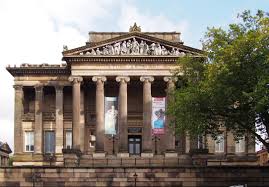
In the Collections Development Policy statement (2011) of the Harris Museum and Art Gallery (Preston, UK) there is a fascinating, and, for the Bent Archive, startling reference on page 30:
‘In the long term, the following areas of the collection have been identified as under-researched areas, but these would only be tackled in the context of potential for use and visitor engagement … […] Theodore Bent’s Turkish embroidery bequest.’
This casual aside makes the Harris Museum one of only three public collections in the world, to our knowledge, to hold a collection of textiles originally acquired by Theodore and Mabel Bent over the 20 years of their travels, the other two being the Benaki Museum, Athens, and London’s Victoria and Albert Museum. (We are not including here the few clothing and other items, some made of bark, that the Bents brought back from Great Zimbabwe that are now in the British Museum.)
‘Theodore Bent’s Turkish embroidery bequest’ at the Harris Museum consists of four items (we are assuming they represent the entire ‘bequest’), and, thanks to the kind assistance of curator Caroline Alexander, we believe that this is the first time they have been ‘published’.
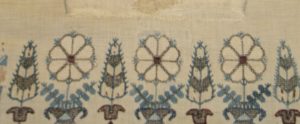
The museum’s Accession Book refers to the pieces as ‘Turkish Embroideries’. In the 1880s, the decade the Bents spent mainly in the Eastern Mediterranean, the islands off the Turkish west coast belonged to Turkey, taken and held by the Ottomans from early medieval times until the early 20th century. The Dodecanese islands were only returned to Greece in the 1940s. Thus the Bents’ acquisitions of fabrics and costumes (some with the intention of selling on to British collectors and institutions) reflect a wide blend of styles and influences – the distinctions between ‘Greek’ and ‘Turkish’ being generally moot points. Beautiful things, made painstakingly, to be given, worn, or displayed, remain beautiful things irrespective.
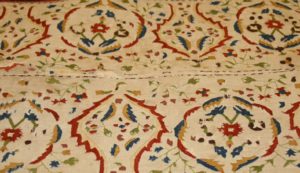
The four items (1970.1; 1970.2; 1970.3; 1970.4) in the Harris Museum were donated in May 1970, rather mysteriously, by someone who introduced herself as ‘the great-niece’ of Theodore Bent. There seems to be no mention of the gift in the museum’s Donation Book, an interesting fact, nor does any name appear in the museum’s accession records unfortunately. The museum’s Accession Book includes the following handwritten note stapled to the relevant entries: ‘Query re T. Bent’s niece [sic]. No details of this donation in the donation book. Contact V & A to whom T. Bent donated embroidery.’
Enquiries are under way (December 2019) to try and find out who the donor may have been, and why the Harris should have been chosen as the recipient.
Theodore Bent had no siblings, but several cousins, who in turn had issue. There is a chance that one of these might be our donor, and there is a local connection. Theodore Bent himself had property just outside Macclesfield , and his uncle John was Lord Mayor of Liverpool in 1850. The family were influential local brewers, and, indeed, Theodore was born in Liverpool (1852). Bent’s Brewery Co. Ltd remained in business until the 1970s, as part of Bass Charrington. The Bents can be traced back to the Liverpool region in the 1600/1700s, and were potters and brewers – one, a medical man, was the famous surgeon who amputated Josiah Wedgwood’s leg!

Thus perhaps it was a member of this energetic and successful family who donated the embroideries in 1970; but somehow we doubt it. The Bents were great collectors (and dealers) in embroideries, etc., on their travels in the Eastern Mediterranean and Turkey in the 1880s, the period, we assume, when the four pieces now in the Harris were acquired by the exploring couple. On Theodore’s death in 1897 all his estate went to his wife Mabel, and they had no children. Just over thirty years later, on Mabel’s death (1929) all her belongings, including her textiles, went to her surviving nieces – they, in turn, had daughters, who would thus have been the ‘great nieces of Mrs Theodore Bent’. Of these, it seems only Kathleen Prudence Eirene Bagenal (1886-1974) was alive in 1970. (For the Anglo-Irish Hall-Dare family click here.)
We may, therefore, tentatively, and for now, propose Kathleen Bagenal (or her agent) as the donor of the Bent textile bequest to the Harris. The mystery remains why the Harris? Kathleen’s family home was in Scotland (Arbigland, on the Solway Firth), and we know that she was actively selling off her great-aunt’s textiles from the 1930s. We will, of course, update this theory if more information comes our way.

In her lifetime Mabel exhibited some of her fabric collection – we know of two events, but neither seem to have included any of the four items donated to the Harris in 1970.
- A lecture Bent gave to the Anthropological Institute of Great Britain and Ireland in 1886, during which his Mabel displayed a range of their textiles. These are published in ‘Insular Greek Customs’. The Journal of the Anthropological Institute of Great Britain and Ireland, Vol. 15 (1886), 391-403. [With an Appendix by ‘Mrs. Bent’].
- At the 1914 embroidery exhibition at the Burlington Fine Arts Club in London, Mabel Bent showed a good part of her collection (see later in this contribution).
The Bent textiles in the Harris Museum, Preston
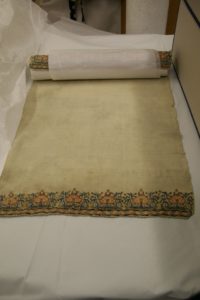
PRSMG: c1970.1 [Headed ‘Turkish Embroidery’ in the museum’s Accession Book]
Accession Book entry: ‘Embroidered with silk and gold plate thread, at both ends. Repeating pattern of formal plant motifs. Pink, blue, gold and brown on natural linen.’ Acquired from: ‘The great-niece of Theodore Bent’. Acquisition dated: ‘April May 1970′.
Digital catalogue entry: ‘Fine linen cloth [dimensions not provided] embroidered at both ends with intricate floral pattern of mainly peach and blue silk embellished with gold. Probably embroidered using a tambour. Possibly Turkish. Note: 2015, Asia from British Museum visited, said possibly Turkish with the use of flattened gold thread.’
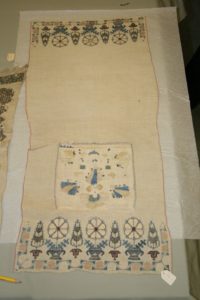
PRSMG: 1970.2 [Headed ‘Turkish Embroidery’ in the museum’s Accession Book]
Accession Book entry: ‘Short strip embroidered at ends with formal design of cyprus tress and flowers in urns. Embroidered patch appliquéd on.’ Acquired from: ‘The great-niece of Theodore Bent’. Acquisition dated: ‘May 1970′.
Digital catalogue entry: ‘Embroidered panel [dimensions not provided] of fine linen. Embroidered both ends with motifs of pinecones and eight-petalled flowers in pots worked in blue, dark brown beige and cream threads. Probably machine worked as no evidence of starting or finishing. Machine worked down two edges. Also central panel later addition in pale blue, beige and cream floral motifs.’
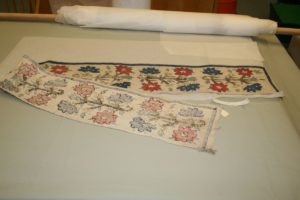
PRSMG: 1970.3 [Headed ‘Turkish Embroidery’ in the museum’s Accession Book]
Accession Book entry: ‘Long strip embroidered with flower motif repeated seven times. Red, brown and blue silk embroidery with blue border on three sides.’ Acquired from: ‘The great-niece of Theodore Bent’. Acquisition dated: ‘May 1970′.
Digital catalogue entry: ‘Embroidered panel of fine linen [dimensions not provided]. Embroidered with floral motifs along length. Motif of red and blue flowers in repeated and alternating pattern. Appears to have been the edge of a larger panel. Believed Turkish c 19th century.’
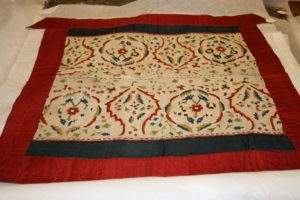
PRSMG: 1970.4 [Headed ‘Turkish Embroidery’ in the museum’s Accession Book]
Accession Book entry: ‘Red silk cloth square extended at corners. Two embroidered panels joined to form centre piece, with blue silk strips on two sides. Floral design.’ Acquired from: ‘The great-niece of Theodore Bent’. Acquisition dated: ‘May 1970’. [This entry in a different hand]
Digital catalogue entry: ‘Embroidered panel [dimensions not provided] of floral motifs on fine linen comprising two pieces joined in the centre. Primarily terracotta red, blue, green and mustard thread working arabesque floral design. Panel has terracotta coloured narrow lace edging. Panel has been mounted on dark red silk backing panel with sleeves top and bottom for hanging. Possibly Turkish. c 19th century.’
The 1914 embroidery exhibition at the Burlington Fine Arts Club, London
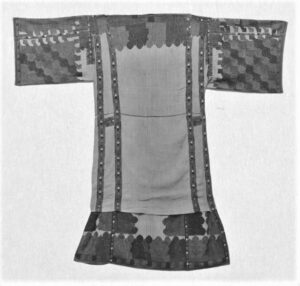
As mentioned above, Mabel Bent showed a good part of her collection at the 1914 embroidery exhibition at the Burlington Fine Arts Club in London. There is an an online catalogue. The prize exhibits were a collection of fine dresses from the Dodecanese, now in the Benaki Museum, Athens, and the Victoria and Albert Museum, London. The exhibition cabinets displayed a wide range of Mabel’s other textiles, but none of the four items now held in the Harris Museum seem to have been shown to the public in 1914, but more research is needed to confirm this (i.e. future access to the exclusive photographs of the exhibits). Readers may be able to identify the Harris pieces in the catalogue (search ‘Bent’ in the online catalogue search box that appears on the page), and if so we would be delighted to hear from them. Similarly, if any Preston readers can provide information on the four Harris pieces before they entered the collection in 1970, we would also be most interested.
Mabel Bent’s diaries are, occasionally, a useful primary source for information on the thousands of artefacts the couple returned with to London during the twenty years of their travels in the Eastern Mediterranean, Africa, and Arabia. There are hundreds of references to dress, costume, embroideries, fabrics, etc. Unfortunately, Mabel does not always give precise details of gifts and acquisitions and it has not been possible to identify the four textiles in the Harris bequest in her notebooks.
“This afternoon we have been to the doctor Venier, of a Venetian family. Dr. Venier showed us the hangings of a bed, in which King Otho slept when he visited Pholégandros. All gold lace, silver lace and the most beautiful silk embroidery on linen. The curtains were striped silk gauze with gold lace insertion. The pillows gold edged real silk. We were also shown lace-edged sheets and gold embroidery. It was a really splendid sight and fit for a museum.” (February 1884, Folégandhros in the Greek Cyclades; ‘The Travel Chronicles of Mrs J Theodore Bent’, vol 1, page 44, 2006, Oxford)
In conclusion, the four textile pieces discussed, once in the collection of Theodore and Mabel Bent and donated to the Harris Museum and Art Gallery, Preston, represent an important revelation, and are published, it is thought, for the first time here. If you have any comments on any aspect of this content, including the origins, or technical/stylistic features of the four textiles, do please write in.
 Leave a comment or contact us about this article
Leave a comment or contact us about this article